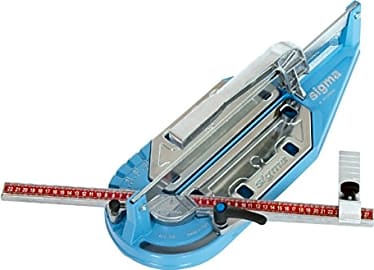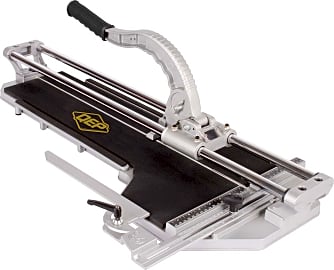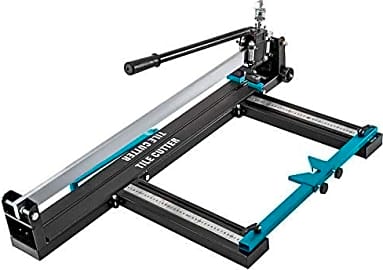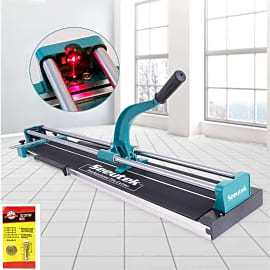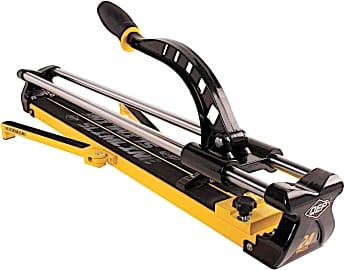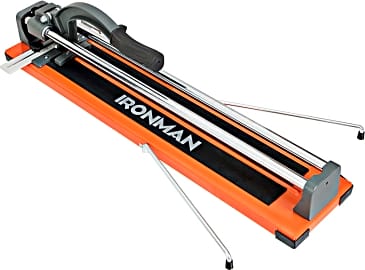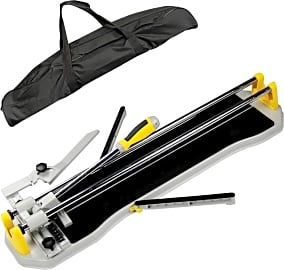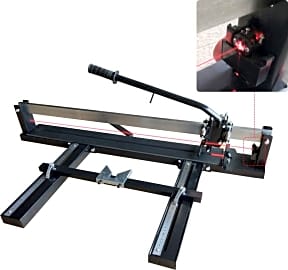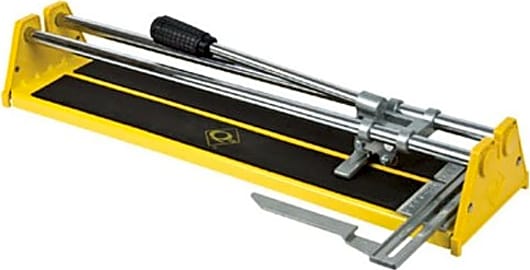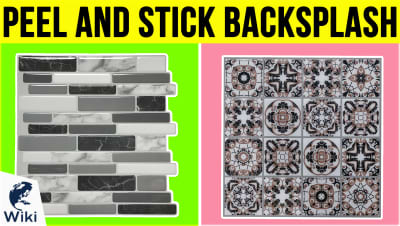The 10 Best Tile Cutters

This wiki has been updated 23 times since it was first published in July of 2019. Favored for being durable, low-maintenance and stylish, humans have been working with decorative tile for millennia. Although there are plenty of wet saws on the market, our rankings for the best tile cutters are focused on manual options. These tools allow users to make clean, precise breaks in a fraction of the time saws take, without creating a bunch of dust or using any electricity. When users buy our independently chosen editorial recommendations, we may earn commissions to help fund the Wiki.
Editor's Notes
February 19, 2021:
Modern mechanical tile cutters are composed of a flatbed with an adjustable rest that allows for accurate and repeatable cuts. A hardened scoring wheel is pushed over the surface of the tile using a sliding arm and the right amount of applied pressure and, finally, the tile is snapped along the scored line using the breaker bar. Although this design has been around since the 1950's it is still by far the most popular as it is the most efficient way to achieve accurate cuts in a very hard material.
In this update, we removed some models due to availability concerns and selected several new models to complete the ranking. The HiHydro Professional was added due to its extra-long base of just over 1-meter in length, making it an ideal choice for very large materials, that combined with a laser guide and a single rail design makes it a very capable machine, suitable for rigorous professional use. The QEP Slimline is also a great choice for tradesmen, as it has a very narrow footprint of just over 5 inches and a low weight of only 12 pounds, making life easier when loading and unloading the work vehicle and when moving around the job site. Finally, the Mophorn 31 Inch is a good all-round machine made from heavy-duty steel. It features an adjustable tile rest that can be attached to either side with an adapter for cutting at a 45-degree angle, and its built-in oil reservoir keeps the bearings lubricated so that the sliding mechanism doesn't become clogged up and jam. This model is a little heavy at just over 40 pounds, however, there is an aluminum version that, although not as durable, is cheaper and much lighter.
August 04, 2019:
Tiling is an art form that human beings have perfected over millennia. Favored for being durable, low-maintenance and stylish, some common materials modern tiles are made from include ceramic, porcelain and glass. Tile installation’s a delicate skill that artisans master over years. But at the same time, its basics are simple enough to entice a competent DIYer to tackle a small project (say a bathroom floor or kitchen backsplash) around the house.
Although it’s a labor-intensive practice, relative to other parts of the construction process tiling requires a fairly minimal investment in tools. The largest equipment expense a professional tiler will incur will likely be a tile wet saw. Saws are great for cutting narrow pieces of fragile tile, or thicker tiles that are tough to snap, but they have a number of drawbacks: they’re expensive and slow, they require electrical service or the use of a generator on site and they create a ton of fine dust during cutting – which almost demands immediate investment in a shop vacuum and respirator.
This is where manual tile cutters come in:
Manual tile cutters apply the ‘score-and-snap’ method to make precise, clean cuts: making a single pass (Don’t do more than one! That’s how uneven cuts happen.) across a tile with a cutting wheel – scoring the tile, then applying gentle pressure to either side of the line – snapping the tile.
In most situations, most professional tilers will reach for a manual cutter before a tile saw because they’re more portable, less messy and significantly faster than the alternative. Manual cutters are a fairly safe to operate, as far as tools go, but gloves and safety glasses or a face shield are still recommended, lest you come up against a jagged edge or flying tile fragment.
Here’s a few things to keep in mind while you’re shopping in this category:
What kind of tiles do you need to cut? While most the offerings in this category claim to cut porcelain, ceramic and glass tiles, users working with tougher materials might want to consider investing in a higher-end option. For example, the Italian-made Sigma 2G is rated to cut granite and marble tiles, while the Montolit 63P3 (also manufactured in Italy) simply promises to cut all types of tiles up to 22 millimeters thick. For those working with a tighter budget, the Goplus 24 Inch is a more-affordable option that also claims to be suitable for all kinds of tiles, although only up to 12 millimeters thick.
What size of tiles do you need to cut? If you’re only working with small tiles, say less than 20 inches in length, then this might be an inconsequential consideration for you. However, if you’re getting any larger than that, you might be hindered by the maximum-size rating of your cutter. Although 24 inch appears to be the most common size in this category, there are larger versions available. Thirty-six and 48 inch models from top companies can be quite pricey, but the Seeutek Manual Tool is one option that offers quite-affordable larger models.
How important is portability? If the tool you’re shopping for is destined to tile your basement bathroom, then forever collect dust in your storage shed, then this might be another inconsequential consideration for you. However, if this a device you plan to be hauling to jobsites for years, then you might want to pay some heed to the tool’s weight. With options weighing anywhere from less-than-five-pounds to more-than-30-pounds, your apprentice might thank you for selecting a leaner option, However, it should be noted that, at times, there can be a proportional relationship between a tool’s weight and durability. Try to strike a happy balance when picking the model that’s right for you.
Although these are fairly simple tools to operate, there is a knack to them, and each tile’s a bit different to cut. With plenty of videos online offering free advice from professionals, take some time to do a bit of research, read your manual, and make sure you purchase enough material to allow for a few practice cuts before you get started. Happy tiling!
Special Honors
Rubi Invented and patented the first professional tile cutter in 1951, and were the first to implement tungsten carbide scoring wheels. Since then the company has continued to innovate and improve its products, with their current range offering everything from pocket-sized cutters, to high capacity models, for modern materials like porcelain and travertine. rubi.com
leggera Designed and manufactured in Italy, this range of cutters boasts professional quality at affordable prices. It also happens to include one of the longest on the market at nearly 140 centimeters and since it's made from aluminum also one of the lightest. battipav.com


